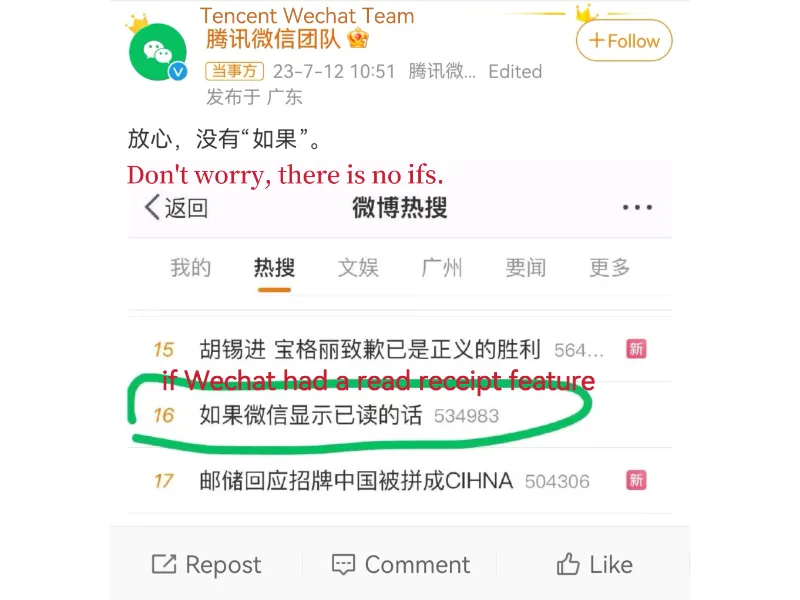- BlackBerry introduced the read receipt feature in 2005, which garnered significant attention at the time. Subsequently, many social platforms adopted this feature into their platforms.
- While the read receipt feature has the potential to enhance productivity, it is met with disfavour by many individuals who seek ways to circumvent being notified that they have read a message.
- The introduction of read receipts by social platforms is believed to provoke negative emotions and contribute to users becoming dependent on their apps.
When a message is marked ‘read’ on a social media platform, do you find yourself constantly checking for a reply or feeling anxious if one doesn’t come? While read receipts enhance communication efficiency, they can also become an annoyance, prompting a reflection on their impact on our digital interactions.
Who brings the read receipt feature?
In 2005, BlackBerry launched BlackBerry Messenger (BBM), offering users an alternative to SMS communication through its unique PIN system exclusive to BlackBerry devices.
The introduction of read receipts became a standout feature of BBM during this period of less convenient communication methods. This feature allowed users to establish real-time connections and quickly determine the status of their messages, reflecting the growing demand for immediate communication feedback.
In 2006, BlackBerry applied for a patent for this feature under “Handling notifications in instant messaging systems,” detailing the implementation of delivery and read receipts within BBM.
Today, read receipts have become a sought-after feature across major platforms, with Apple showcasing similar functionalities in iMessage during its 2011 developers conference.
While the consumer version of BBM has been discontinued, its legacy persists through the widespread adoption of read receipt technology in modern chat software. Initially conceived as a tool for real-time status updates, read receipts have endured as a favoured feature among platform operators despite evolving attitudes towards digital disconnection.
Also read: Who is Vitalik Buterin? From university dropout to Ethereum mastermind
Why do many platforms include a read receipt feature?
A questionnaire was conducted within the BTW reporter team to gauge perspectives on the demand for the read receipt feature across e-commerce, social, and work platforms. Fifteen members participated in the survey. Among them, twelve colleagues expressed a preference for implementing the read receipt function in e-commerce platforms. One opposed its implementation, while two others were indifferent.
In online shopping platforms, the read receipt feature can create a dynamic where both buyers and sellers feel pressure to respond promptly, thus facilitating transaction completion. For sellers, this feature offers insights into where communication breakdowns occur, potentially leading to customer loss. Additionally, it allows them to gauge customer interest based on message status, enabling tailored sales strategies. A swift reply post-read indicates heightened customer curiosity, stronger purchase intent, and increased transaction likelihood. This encourages sellers to expedite responses, aligning with customer expectations and the principle of prioritising customer inquiries—a fundamental aspect of customer service.
In work platforms, there’s a greater inclination among the team members towards having the read receipt feature. In this context, it serves to streamline communication, saving time by eliminating unnecessary replies, enhancing message delivery efficiency, and preventing misunderstandings or shirking based on unread messages.
Also read: Who is Jeff Weiner? LinkedIn former CEO epitomises ‘compassionate management’
China doesn’t use read receipts
However, in social platforms characterised by strong social interactions like WeChat, Instagram, and X, the sentiment is largely against displaying read statuses. In China, major social platforms such as WeChat, QQ, and Weibo do not incorporate a read receipt function, reflecting the preference for privacy and less pressure on immediate responses in social interactions.
Last year, the phrase “if WeChat had a read receipt feature” became a hot topic on Weibo. The majority of netizens expressed opposition to this idea. Many argued that such a feature would disrupt the unspoken understanding between individuals, pressuring message recipients to respond immediately. Failure to reply promptly could lead to negative labels such as “rude” or “unfriendly.” Some even mentioned that if this feature were implemented, they might avoid opening messages altogether to avoid these expectations.
WeChat officials responded to the debate by reassuring users, stating, “Don’t worry, there are no ifs.” which suggests that WeChat has no plans to introduce a read receipt feature, alleviating concerns among users who were apprehensive about potential changes to the platform’s messaging dynamics.

It can turn into ’emotional abuse’ sometimes
In earlier times, features like return receipts for registered mail or delivery status notifications in emails served the purpose of confirming successful message delivery when communication wasn’t as instant. However, read receipts can often be seen as more of a nuisance than a useful feature today, adding to the pressure of always being available and responsive.
Read receipts often trigger anxiety on social media platforms. They place recipients in a dilemma, as they may have read the message but are not able to respond immediately. What’s more, when we receive a message from a long-lost friend or an invitation from an unfamiliar colleague, the read status removes our ability to “hide.” We can only reply with honesty and transparency.
When recipients notice that their messages have been read but not replied to, they often experience self-doubt and concern. They may question if they said something wrong, unintentionally upset the other person, or wonder why the person is not responding, especially when the other person has replied to messages in the group chat but not specifically to theirs.
Some people take advantage of this and deliberately make the other person feel uncomfortable by not coming back with a “rbomb”, which was added to the Urban Dictionary in 2011. The term is also interpreted with a sense of resentment: reading a message without replying or ignoring it is usually intentional.
Read receipts can have their benefits, but when they “invade” our lives and try to “spy” on our every movement on social media platforms, it’s understandable that many people would choose to turn off this feature.
Who truly needs this feature? Users or social platforms?
“You don’t realise it but you are being programmed,” Chamath Palihapitiya, a former senior executive of Facebook, said in a speech at an event run by the Stanford Graduate School of Business.
The read receipts feature has been a point of controversy since its introduction. While users may find it stressful, platform operators often see it as a “masterpiece” that increases user engagement and revenue. This focus on platform metrics and revenue generation may sometimes overshadow user preferences.
Users often find themselves repeatedly checking the app to see if their messages have been read or if the other party is replying, playing into the goals of app operators to increase user engagement and data contribution. Although it may lead to feelings of anxiety or frustration, the feature contributes to users spending more time on the platform and providing more data.
Similarly, Snapchat and QQ have introduced “Chat Sparks,” a feature that awards users a spark or another special symbol after maintaining a continuous chat streak with a friend for certain days. However, users must chat daily to sustain this “spark.” Some teenage Snapchat users exhibit negative reactions when the “spark” disappears, indicating the emotional attachment and significance they associate with this feature.
Professor Tony D. Sampson, who specialises in digital media culture and communication at the University of East London, argues that social media’s “read receipts” are deliberately crafted to foster addiction among users. These features trigger negative emotions linked to compulsive behaviours, contributing to the addictive nature of these apps.
For software operators, encouraging users to engage in extensive chat interactions and spend significant time within their platforms is a key strategy for generating revenue.

